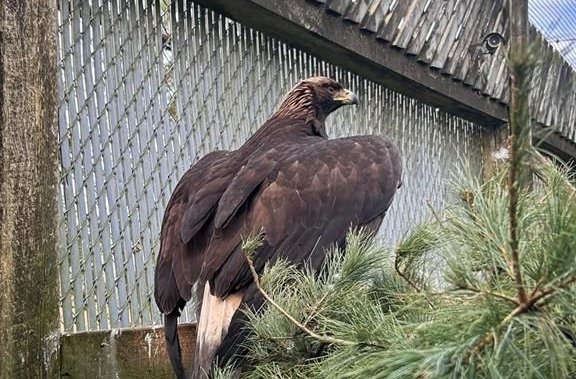A golden eagle found in Prince Edward Island is not a common sight, especially in the Maritimes. The bird was discovered grounded in the middle of a road in November, appearing sick or exhausted. P.E.I. Wildlife Rescue and Rehabilitation Inc. was contacted, and Candy Gallant assisted in securing the bird until it could be rescued. The bird was eventually retrieved by a Humane Society officer and taken to Hope for Wildlife in Seaforth, N.S., where it was determined to be healthy, despite its unwillingness to fly at first. The bird was placed in a flight cage with a bald eagle for company and observation while it recovered.
Golden eagles, similar in size to bald eagles, are known for being fierce predators that catch live prey, such as rabbits, hares, and ground squirrels. While they are mainly found in Western North America, some golden eagles migrate great distances in the winter to find better areas for hunting. This specific golden eagle in Prince Edward Island is believed to be a wandering migrant from Western Canada, making it a rare but not unheard of sighting in the Maritime provinces. The bird was given a full exam at Hope for Wildlife, where it received care and was expected to be released once the weather improved.
Hope Swinimer, founder of Hope for Wildlife, mentioned the excitement of seeing a golden eagle at the center, as they are not commonly encountered. The center saw an increase in rescue cases the previous year, but the success in rehabilitating the golden eagle was a positive outcome. The bird was placed in a flight cage with a bald eagle for companionship, with volunteers closely monitoring their interactions. Swinimer expressed the hope to release the golden eagle once the weather conditions were optimal, but mentioned that the center would keep the bird all winter if necessary.
The volunteers at Hope for Wildlife described the golden eagle as a beautiful and streamlined animal that appeared to be made for speed. The bird’s recovery and strength were a positive sign, indicating that it had worked through whatever had been ailing it initially. The golden eagle was provided with the necessary care and attention to ensure its successful return to the skies. The volunteers mentioned that the golden eagle and the bald eagle housed together in the flight cage were compatible and did not exhibit any signs of aggression towards each other.
Nick Lund, a network manager for Maine Audubon, provided details about the characteristics and habits of golden eagles, noting their size, weight, and wingspan. He explained that while bald eagles primarily feed on fish and carrion, golden eagles are known for their ability to catch live prey, including larger animals like sheep and deer. The presence of a golden eagle in the Maritimes is attributed to its migratory patterns, with some individuals traveling great distances in search of better hunting grounds during the winter. The golden eagle found in Prince Edward Island was likely a wandering migrant from Western Canada.
Despite the rarity of golden eagle sightings in the Maritime provinces, the bird’s presence in Prince Edward Island was a unique opportunity for wildlife enthusiasts and conservationists. The successful rescue, rehabilitation, and imminent release of the golden eagle by Hope for Wildlife highlighted the importance of wildlife rehabilitation centers in caring for injured or exhausted animals. With proper care and attention, the golden eagle was able to regain its strength and prepare for its continued journey in the wild. The collaborative efforts of individuals and organizations involved in the rescue and recovery process demonstrated a commitment to protecting and preserving Canada’s diverse wildlife species.


